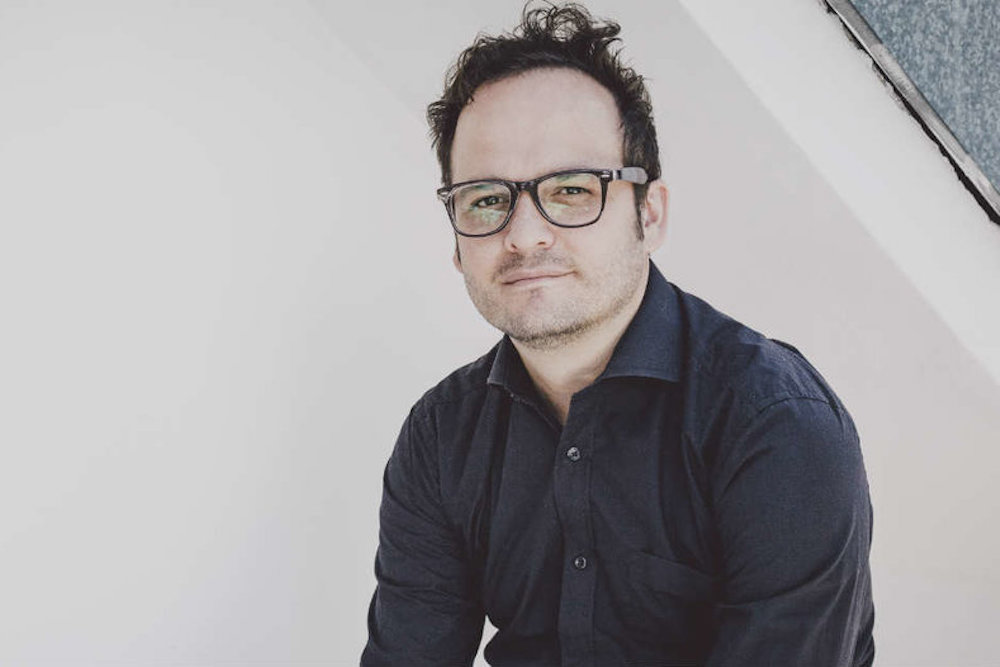In Juan Cárdenas’s novel Ornamental, the city has no name. It could be here, or anywhere. Its location in time isn’t specified either. There’s a faintly futuristic overlay, but the narrator’s diction swings between antiquated formality and present-day slang, and, among other anachronistic details, there are both spider monkeys and henchmen on the security team. Characters, too, are referenced only by generic designation. “My wife,” “the directors,” “the taxi driver,” “the architect.” Even descriptive nouns of that kind are withheld from the study participants, who have volunteered for the trial of a new recreational drug that exclusively affects women. They’re granted only numbers.
The choice to leave those coordinates unfixed suggests universality, as if this same story might have played out (might be playing out) in any number of labs, in any number of cities. But it also enacts the social and political repression of a certain kind of anonymity. “A city can’t be talked about without names, it’s impossible,” number 4 says. “It’s all been worked out so the story stays neatly inside the mute numbers.” How, Ornamental asks, do the nameless—disembodied voices, unattributed speech, figures “emancipated from any arithmetic”—participate in meaningful discourse, find a place among others, work toward common interest, tell their stories? And when do we encounter those stories, as readers who live in named cities and bear names ourselves?
Once, Juan pointed out that architecture can function as “a sculptural representation of failed futures.” In this city scarred by absurdities, crises, injustices, our surroundings offer clues, to where we’ve been, to where we’re going. There are “forsaken relics of late-fifties Creole functionalism” in the old financial center. The exploitative hacienda has been repurposed as an equally exploitative pharmaceutical lab. The “prodigious, lost-era” skyscrapers were abandoned “on the brink of rationalism.” Buildings—their designs and locations, the condition they’re in, what they replace and what they conceal—record histories and gesture toward onetime paths forward. Even the most “gleaming and beautiful” ones, the ones once symbolic of “prosperity” and “progress,” recede into the unchanging chaos of the landscape, just as “yesterday’s political discourses [become] today’s collective unconscious.” Ornamental can be read as a building can be read: as an object that records, with its highly stylized language and form, an interplay between ideologies. Its material details (language, texture, composition) tell us as much if not more than what would traditionally constitute plot.
A doctor’s self-consciously formal discourse is interrupted at intervals by number 4’s elaborate poetic outpourings. It’s interrupted, but never wholly consumed. The doctor’s wife, an artist whose works are overpriced “ornaments,” is moved by number 4 to interrogate her practice, but only before fleeing back to the comfortable “fortress” of her taste. The excess, ephemerality, and exuberance of number 4’s monologues are set alongside a sanitized and selective reality. They’re the glints of the baroque against Loos’s white walls. On the level of plot, the conflict is won by those walls—by rational, ordered discourse, smooth and functional surfaces, the conditions called for, in this case, by those who hold power. The novel ends not with any comforting resolution but with a return to the vortex of late capitalism. The scales tip back in the direction of privilege, or they never tip away. Evil can be observed but not upended; our irredeemable characters can’t right a world gone wrong.
But that’s not to say there’s no relief. Because on the level of the sentence, there’s still some room for astonishment: in the reactions sparked off when two lexicons are pushed up against each other, in the interplay of linguistic subtleties. There, the winner of this conflict doesn’t seem to be determined from the outset. Because if education and upbringing are a prison, as Ornamental suggests, then so is language, which turns moments of rupture or linguistic difference into alternate paths of significance. When the study participants speak for themselves, contrasting styles puncture the doctor’s grandiose and often classist rhetoric. Their survey responses are discrete poems that show what shape expression can take outside of narrow conventions. They’re open to interpretation, vivid beyond the homogenizing constraints of grammar, unselfconscious and instantaneous. In these brief moments of potential, language that doesn’t conform to certain imposed expectations proves as powerful and expressive as language that does. Both the doctor and his wife return to their lives of ease after number 4’s departure. Both reassume the narratives they’ve carefully crafted for themselves. If number 4 has any visible or lasting effect on their lives, it may be only in the way the collar of the doctor’s prose loosens, the naturalness and idiomatic expression it occasionally admits.
With whom do we empathize in such a book—a book described as an exploration of art’s potential “for the examination of evil”? For our characters, there is no redemption, no lesson learned, no call to action. Each one is, as we are, “prisoner of [an] upbringing.” And their world, like ours, is deeply flawed, deeply violent, deeply unjust. But with them, we see things we might not otherwise see, go places we might not otherwise go, witness our own circumstances drawn out to their logical conclusions. How do we look and listen from now on? Do the stories remain “neatly inside the mute numbers”? Perhaps, as readers, that’s for us to say.
Lizzie Davis is a translator from Spanish to English and editor at Coffee House Press. Her recent projects include works by Pilar Fraile Amador, Daniela Tarazona, and Elena Medel, and her cotranslation of Medel’s Las maravillas with Thomas Bunstead is forthcoming from Pushkin Press. She has received fellowships from the Omi International Arts Center and the Breadloaf Translators’ Conference in support of her translations.
Used by permission from Ornamental (Coffee House Press, 2020). Copyright © 2020 by Lizzie Davis.
from The Paris Review https://ift.tt/2WtXZQC

Comments
Post a Comment